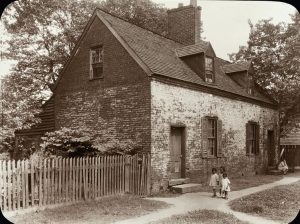
From the Central Rappahannock Regional Library
Black Laws of Virginia: A Summary of the Legislative Acts of Virginia Concerning Negroes from Earliest Times to the Present by June Purcell Guild.
A fascinating and disturbing volume originally published in 1936.
Civil Rights: Fredericksburg's Story.
In this forum sponsored by the Young Adult Department of the Central Rappahannock Regional Library, leaders from Fredericksburg discuss their experiences with racism and the city's response to the civil rights struggle of the 1960s. Participants included Gladys Todd, Mamie Scott, Johnny Johnson, Lawrence Davies, and George Van Sant. On video.
A Different Story: A Black History of Fredericksburg, Stafford, and Spotsylvania, Virginia by Ruth Coder Fitzgerald.
The most comprehensive history of African Americans for this region. Published in 1979. Includes an index.
Coping with Jim Crow: Black Education in Fredericksburg, Virginia, 1905-1963 by Catherine Greer OBrion.
A detailed account of the founding and maintenance of the private Mayfield High School and the struggles that occurred until full integration of the public schools in 1968.
CRRL Presents:
Video interviews of singer/songwriter Gaye Adegbalola and artist/teacher Johnny Johnson.
Four Mayors of Fredericksburg: An Oral History by Archer Williams.
Includes a lengthy interview with then-Mayor Lawrence Davies, Fredericksburg's first African American mayor (1976-1996).
Liberty Street by Candice Ransom
In this children's story set in antebellum Fredericksburg, a young enslaved girl plans her escape with the help of the African American community.
Liberty Town: The Past and Present of a Fredericksburg Suburb by M.B. Gatza.
Published by the Center for Historic Preservation, Mary Washington College (UMW) in 1994.
Local Sources for African-American Family Historians: Using County Court Records and Census Returns by Joan W. Peters.
List of Male and Female Colored Voters, 1904-1905, Fredericksburg, Virginia.
A snapshot of African American voters at the turn of the last century.
Pieces of the Past: Oral Histories:
These projects were undertaken by the Historic Fredericksburg Foundation, Inc.
Johnny P. Johnson: came to Fredericksburg in the late fifties. Taught art at Mary Washington College, then an all-girls' school, and later at James Monroe High School. Mr. Johnson was in the thick of the integration struggles. He helped form the Young Men's Club, calmed down the local disturbance in the 1960s, and was one of the leaders of the march in downtown Fredericksburg after Martin Luther King, Jr.'s assassination.
L. Reginald Lucas: remembers going swimming with kids from the Young People's Baptist Union behind Shiloh Old Site Baptist Church. He was in one of the first batches of African American Marines recruited. He tells of discrimination during his service, including being forced out of a foxhole at gunpoint by fellow Marines when under fire because of his skin color. He also mentions prominent African American physicians, the days of segregated movie theaters, and his feelings during integration.
Lee Roy Lewis: details of the early development of Mayfield and all the things his mother did to make money for her family, including breaking sumac, gathering cress for salads at restaurants, and selling milk from her own cows.
Coleman Maurice Tate: born in 1920 and went to the Philadelphia College of Pharmacy and Science on scholarship because MCV would not accept African American students. Includes much information on African American businesses of the past and baseball games at Fredericksburg's Gouldman Park.
Gladys Poles Todd: shares memories of growing up next to "the old slave block." She taught in Stafford and later in Fredericksburg, at the then-segregated Walker-Grant. She tells of early efforts to integrate youth groups and social friction. Also mentioned: the beginnings of Harambee 360 dance group and the NAACP.
Julia Tyler: born in 1889 in Fredericksburg. She looked after children in the neighborhood whose mothers were working. She helped start a preschool and tells of how she stood up for herself when working as a maid.
Virginia Landmarks of Black History: Sites on the Virginia Landmarks Register and the National Register of Historic Places.
Lists 64 places of interest and tells of churches' and universities' contribution to African American leadership in the state.
Virginiana Files of Interest:
The Fredericksburg drawers contain a section marked BH for Black History. Some highlights include Brown v. the Board of Education-Local Impact, Cincinnati-Underground Railroad, James Farmer, Integration, and The Mayfield Civic Association.
On the Web
1885 Business Directory
Includes listings of officers of African American lodges in Fredericksburg
Fredericksburg Research Resources
Of special interest: online city directories (not delineated by race), indices for Fredericksburg newspapers, Fredericksburg Council Minutes (1782-1800), and the Historic Court Records Project.
George DeBaptiste
George DeBaptiste was born in Fredericksburg in 1815. He worked as a free man for General and later President Harrison. After his move to Detroit, he became a successful businessman and took courageous personal risks as a conductor on the Underground Railroad and helped to raise an African American regiment for the Civil War. These detailed obituaries date from the 1870s and use the language of the period.
The Geography of Slavery in Virginia
A digital collection of advertisements for runaway and captured enslaved persons and servants in 18th- and 19th-century Virginia newspapers. Building on the rich descriptions of individuals in the ads, the project offers a personal, geographical, and documentary context for the study of slavery in Virginia, from colonial times to the Civil War.
Shiloh Baptist Church (New Site)
A history of the congregation. Shiloh New Site split from Shiloh Old Site in 1887. Gives information on New Site's involvement with the Civil Rights Movement and early African American education.
Shiloh (Old Site) Baptist Church
This site has a timeline of the church's history, an early history (1807 through 1878), a list of church members from 1854-1856, and a personal remembrance of Shiloh Old Site from 1921 to 1946.
This webliography accompanied the Lunch With History lecture "A Discussion of Black History in the Development of Fredericksburg" presented by Jervis Hairston, then Vice President, Residential Division Silver Companies, on May 18, 2005.

